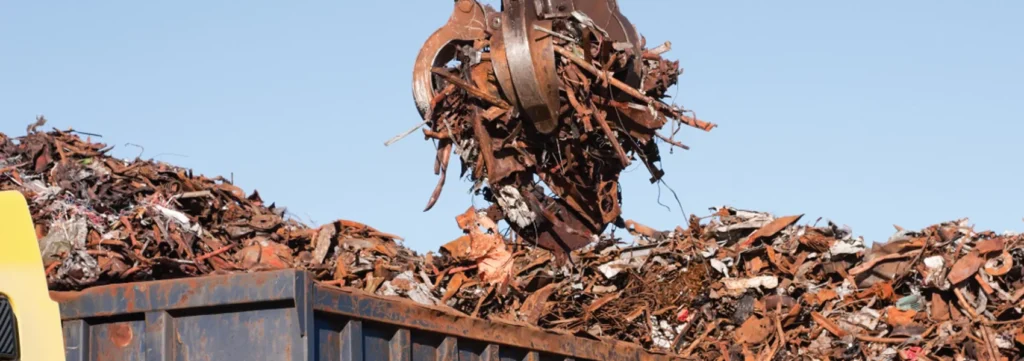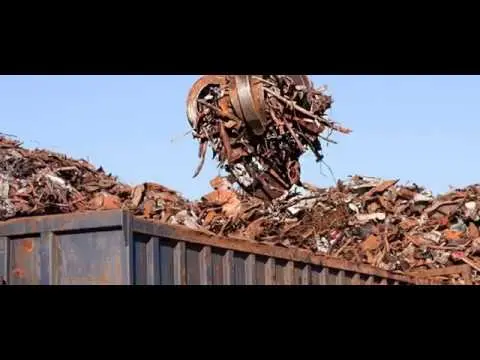Industrial Scrap Metal – Types & Processing
Industrial scrap metals are an important component in today’s industrial sector, offering a wide range of benefits and playing a pivotal role in sustainability and environmental protection.
Below we look at the various aspects of industrial scrap metals, including their types, benefits, recycling processes, challenges, and innovations. By understanding these elements, businesses and industrial units can make informed decisions about managing their metal scrap efficiently.

Types of Industrial Scrap Metals
Industrial scrap metals are broadly categorized into two main types: ferrous and non-ferrous metals.
Ferrous Metals
Ferrous metals contain iron and are known for their strength and durability. Common examples include steel and iron. Steel scrap is one of the most recycled materials due to its extensive use in construction, automotive, and manufacturing industries. Scrap yards frequently collect and process these metals, ensuring they are reused in various industrial applications. Scrap yards also specialize in assessing, weighing, removing, and stripping scrap metal for recycling. See our full ferrous metal information.
Non-Ferrous Metals
Non-ferrous metals, which do not contain iron, are highly valued for their resistance to corrosion and lightweight properties. Examples include aluminium, copper, and lead. These metals are crucial in industries such as aerospace, electronics, and packaging. Non-ferrous scrap metals are often collected and recycled to meet the high demand for these materials in various sectors. See our information page on non ferrous metals.
Below is a video showing the types of industrial scrap metal:
Benefits of Recycling Industrial Scrap Metals
Scrap metal recycling offers numerous environmental and economic benefits. Here are some key advantages:
Environmental Benefits
Metal recycling helps in reducing the need for mining new raw materials, thereby conserving natural resources. It also decreases energy consumption and lowers greenhouse gas emissions, contributing to a cleaner environment. Recycling scrap metals ensures strict adherence to environmental requirements and promotes eco-friendly practices.
Economic Benefits
Recycling scrap metals can be highly profitable. Businesses can sell their metal scrap to recycling companies, generating additional revenue. This practice also reduces waste disposal costs and minimizes the amount of waste sent to landfills. The recycled metals are often used to manufacture new products, supporting the economy by providing raw materials at lower costs.
Resource Conservation
Recycling scrap metals conserves raw materials like iron, aluminium, and copper, which are finite resources. The ability to recycle a large chunk of copper material from various industrial units further enhances this conservation effort. By reprocessing these materials, the industry reduces the need for new raw material extraction, preserving natural landscapes and reducing environmental degradation.
The Recycling Process of Industrial Scrap Metals
The recycling process of industrial scrap metals involves several steps to ensure efficient reprocessing and reuse. Here is a detailed look at the process:
Collection and Transportation
The first step in the recycling process is the collection of scrap metals from various sources, including factories, construction sites, and industrial units. Companies use trucks and other vehicles to transport scrap metal to recycling facilities. Efficient collection services are crucial for gathering large quantities of scrap metal and minimizing transportation costs.
Sorting and Dismantling
Once collected, the scrap metals are sorted based on their type and quality. Advanced machinery and technologies are used to separate ferrous and non-ferrous metals. Dismantling of larger items, such as old machinery and vehicles, is performed to extract usable metal parts.
Processing and Melting
The sorted scrap metals are then processed to remove impurities. This step involves cutting, shredding, and compacting the metals into smaller pieces. The cleaned metals are melted in furnaces at high temperatures. This step transforms the scrap into a liquid form, making it easier to mold into new shapes.
Reformation and Manufacturing
The melted metals are cast into new shapes and forms, such as bars, sheets, or rods, depending on their intended use. These reformed metals are then supplied to manufacturers who use them to create new products. This cycle ensures that the recycled metals are efficiently reintegrated into the production chain.\
Challenges in Recycling Industrial Scrap Metals
Despite the benefits, recycling industrial scrap metals comes with several challenges:
Contamination
Contaminated scrap metals can be difficult to process. Impurities such as oils, paints, and other materials must be removed before recycling, which can be costly and time-consuming.
Collection Logistics
Efficiently collecting and transporting scrap metal from various locations can be challenging. Companies need to coordinate with different suppliers and manage logistics to ensure timely and cost-effective collection.
Market Fluctuations
The prices of scrap metals can vary significantly based on market demand and supply. These fluctuations can affect the profitability of recycling operations, making it essential for companies to stay updated with market trends and adjust their strategies accordingly.
Innovations in Scrap Metal Recycling
Technological advancements are continuously improving the recycling of industrial scrap metals. Some notable innovations include:
Automation and AI
Automation and artificial intelligence (AI) are being increasingly used in recycling facilities to enhance efficiency. Automated sorting systems and AI-powered analysis tools help in accurately sorting and processing different types of metals, reducing manual labor and improving precision.
Sustainable Practices
Recycling companies are adopting more eco-friendly practices, such as using renewable energy sources to power their operations. These practices help in further reducing the environmental impact of recycling processes.
Future Trends
The future of scrap metal recycling looks promising, with ongoing research and development aimed at making recycling processes more efficient and sustainable. Innovations in material science and recycling technologies are expected to drive the industry forward, providing best solutions for managing industrial metal scrap. Second-hand or downgraded parts are ideal for specific types of projects and are available at heavily discounted prices.
Final Notes
Industrial scrap metals are an essential part of the manufacturing and production industries, offering significant environmental and economic benefits. Through effective recycling processes, companies can reduce waste, conserve resources, and contribute to a sustainable future.
By understanding the types, benefits, and challenges of scrap metal recycling, businesses can implement excellent service practices that ensure the efficient handling and reprocessing of scrap metals. With the continuous advancement of technology and a strong emphasis on sustainability, the future of industrial scrap metal recycling is bright, promising more efficient and eco-friendly solutions for managing industrial waste.

